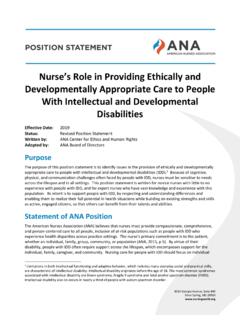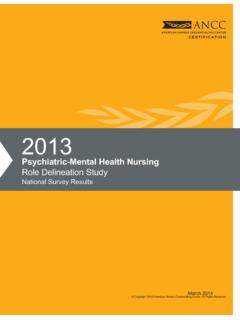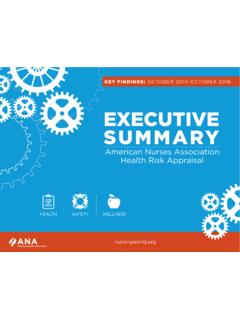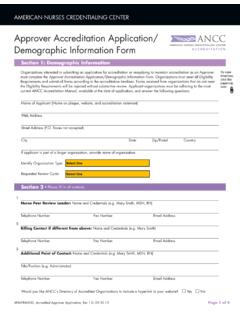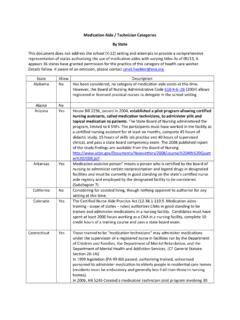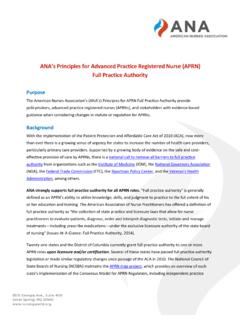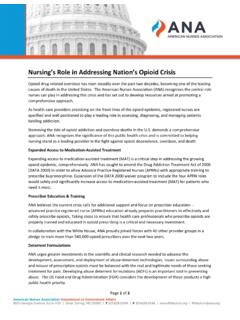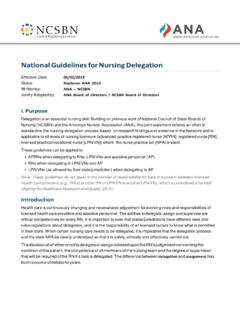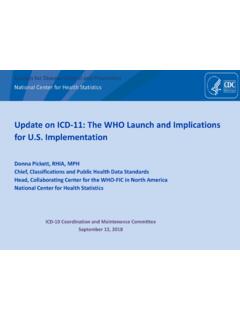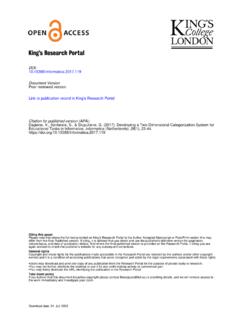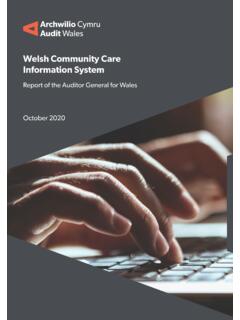Transcription of ROBOTICS AND THE IMPACT ON NURSING PRACTICE
1 ROBOTICS AND THE IMPACT ON NURSING PRACTICECase Study and Pilot Site AnalysesMARI TIETZE & SUSAN MCBRIDEA bout the American Nurses AssociationThe American Nurses Association (ANA) is the only full-service profes-sional organization representing the interests of the nation s 4 million registered nurses through its constituent/state nurses associations and its organizational affiliates. The ANA advances the NURSING profession by fostering high standards of NURSING PRACTICE , promoting the rights of nurses in the workplace, projecting a positive and realistic view of nurs-ing, and by lobbying the Congress and regulatory agencies on health care issues affecting nurses and the Nurses Association 8515 Georgia Avenue, Suite 400 Silver Spring, MD 20910 Copyright 2020 ANA.
2 All rights reserved. No part of this book may be reproduced or used in any form or any means, electronic or mechani-cal, including photocopying and recording, or by any information storage and retrieval system, without permission in writing from the of the Future: What can be taken away that robots can absorb? Dr. Liisa Ortegon, DBA, MAA-OD, BSN, RN, NEA-BC, Houston Methodist Hospital, Senior Vice President of Operations, Chief NURSING Executive, and Entity Business Practices Officer, Wharton FellowIn the future, robots may become as commonplace as today s automobiles, com-puters, and cell phones.
3 Robots will be working in homes and offices; assisting in hospitals, classrooms, and factories; helping to run farms and mines; and exploring in air, on land, underwater, and in space. They will be helping the elderly and people with disabilities in their activities of daily living. They will be helping to perform mundane or dangerous tasks. They will be among the first responders at natural disasters, rescuing people in need and protecting humans from hazards. Teams of humans and robots, large and small, will reliably and efficiently cooper-ate, enriching the quality of life and work for individuals and society Science Foundation (2019).
4 National ROBOTICS Initiative : Ubiquitous Collaborative Robots ( ).v.. ContentsAcknowledgments viiForeword ixExecutive Summary xiGlossary xvService ROBOTICS and the IMPACT on NURSING PRACTICE 1 Introduction 1 Background 2 History of
5 ROBOTICS to Support NURSING 2 Challenges with the Health Care Delivery System 3 ROBOTICS as an Answer to the Challenges 3 Literature Review 5 Search Strategy and Exclusions 5 Current State of the Science on ROBOTICS to Support NURSING 5 Emerging Innovations Coupled with ROBOTICS 8 Future Trends and Economics 9 Broader Market Place of Health Care ROBOTICS 11 Methodology and Case Study of Pilot Sites 13 Methodology 13 Case Study of Pilots in Multiple Sites 14 Description of Case Study Pilot Sites, Workflow, and Tasks Undertaken by Moxi 15 Data Analysis and Interpretation 22 Implications for NURSING PRACTICE 26 Interview with ROBOTICS NURSING Researchers 26 NURSING Care versus Technology 30 Patient Safety and Quality Metrics 31 Policy Formation/ Nurse PRACTICE Act / Roles of Nurses 33 Cost-effectiveness 33 New Possibilities for ROBOTICS 35.
6 Contents vivi ContentsRobotics Application to NURSING PRACTICE 35 ROBOTICS and Leadership from Interviews with Thought Leaders 35 Limitations 36 Case Study Pilot Sites Status 36 Single Source for Service Robot 37 Exploration versus Implementation 37 Future Considerations for Education and PRACTICE 37 Role and Education of Clinical Staff 37 Adoption, Implementation, and Evaluation 37 Research 38 Ethics and Patient Advocacy 39 Policy 40 Economics 41 Conclusion 42 Appendix A: Select Robots from the ROBOTICS Marketplace 45 Appendix B: Summary of Case Study by Pilot Site 49 Appendix C: Charge Nurse Shift Report by Major Activity 53 Appendix D: Charge Nurse Shift Report by Patient 55 Appendix E: Proposed Meeting Agenda for Site Visit by Researcher 57 Appendix F: Theme Categories for Staff Comments 59 References 63vii.
7 AcknowledgmentsThe American Nurses Association and authors sincerely appreciate the participation of these institutions and individuals who were critical to the success of this project. Each are innovative leaders who are advanc-ing the PRACTICE of NURSING and HEALTH PRESBYTERIAN HOSPITAL DALLAS (PHD) EXECUTIVESJ ulie Balluck, MSN, RN, NEA-BC, CPAN, Interim Chief NURSING OfficerErica DeGuzman, Unit SecretaryAmanda Hernandez, BSN, RNKaren Hogg, RN, SupervisorChantae Irving, BSN, RN, SCRN, SupervisorPhebe Iype, BSN, RN, CMSRNAna Lopez, BSN, RNUNIVERSITY OF TEXAS, MEDICAL BRANCH (UTMB)Dr.
8 Tammy Cupit, , RN-BCDr. David Marshall, JD, DNP, RN, CENP, NEA-BC, FAANDr. Josette Armendariz-Batiste, DNP, RN, CENPA shleigh Thomas, MSN, RN, OCNJ uanita Norton, MSN, RN-BC, CPNHOUSTON METHODIST HOSPITAL (HMH)Dr. Lisa Ortegon, DBA, MAA-OD, BSN, RN, NEA-BC, Senior Vice President of Operations, Chief NURSING Executive, Entity Business Practices Officer, Wharton FellowCaroline Mascarenhas, MSN, RN, NEA-BC, Vice President of OperationsJane Ugochukwu, DNP, RN, NE-BC, NURSING DirectorKeonna Gant, MSN, CNML, RN, Nurse ManagerHolly Shui, MSN, RN-BC, CNN, RN IV.
9 Acknowledgments viiiviii AcknowledgmentsJones 9 StaffAlexa Calderon, MHA, Project ManagerPenny Black, RN, Director Clinical SystemsNoemi Garcia, RN, Manager EPIC OrdersChris Farias, EPIC Orders App Analyst IIMarina Klimovich, EPIC Orders App AnalystScott Williamson, EPIC Analyst, ClinDoc/Stork/LTAC/ASAPClay Bourgeois, Information SecurityAMERICAN ACADEMY OF NURSINGANA would like to acknowledge the American Academy of NURSING , Informatics and Technology Expert Panel members for their review of this document: Thomas R.
10 Clancy, PhD, MBA, RN, FAAN, Clinical Professor Ad Honorem, School of NURSING , University of MinnesotaRosemary Kennedy, PhD, RN, MBA, FAAN, Principal and Chief Strategist eCare Informatics, LLCD iane F. Mahoney, PhD, RN, FGSA, FAAN, Professor Emerita, MGH Institute of Health Professions; Principal, Aging Specialist, Dementia & Technology; EDDEE ConsultantDILIGENT ROBOTICS , acknowledge the work of the team of inventors and engineers that contributed to the success of the case study of pilot sites. The team from Diligent ROBOTICS , Inc.
